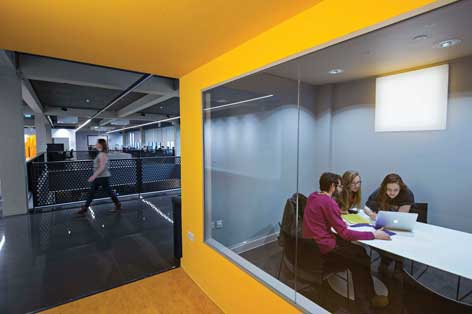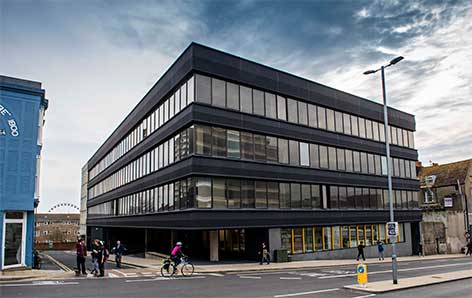Gallery spaces and home to the School of Media.
20 Oct 2016
The opening of the new Edward Street building as the new home of the School of Media, brings with it a whole host of new projects and development opportunities.
The first of these is already apparent in the 7th edition of the Photoworks Biennial exhibition (1 – 30 October, http://2016.bpb.org.uk), . This is a major event and one which Director of Photoworks and the Brighton Photo Biennial Celia Davies feels is ‘like a turning point– the first time the university has had the opportunity to contribute as a major venue - for students and people from the local community as well as international Biennial visitors to see what’s happening around the city in terms of photography, which is really developmental.’
Edward Street is hosting ‘The Dandy Lion Project’, curated by Shantrelle P. Lewis, which explores global expressions of the Black Dandy phenomenon against the backdrop of contemporary life, through over 130 works by 30 different photographers.

With the ‘Dandy Lion Project’ Lewis explores the tension between the accessibility of fashion & style photography and the very real socio-political attitudes that the photographs examine – a reminder of what a powerful tool photography can be, and part of the attraction of the exhibition for Davies: ‘A biennial has, of course, to be serious and rigorous in what it’s investigating but I am also interested in a wider community entering into the discussion and so I wanted to play with what photography does really well, which is its duality of appearing seemingly familiar whilst actually being incredibly active in shaping our own ideas.’
The building is also showing an installation by Nigel Shafran, Fashion shows. whichcombines unexpected images and objects that provide an alternative view into notions of beauty as circulated by the fashion photography industry. By utilising the proximity to the college’s existing Dorset Place exhibition space, visitors can see three different parts of the biennial programme within a very small area. Added to this, an information hub, through which Photoworks sells books, enables a dialogue to take place about the organisation’s role as a national photography development agency.

The biennial is the first in a series of exciting exhibitions coming to Edward Street; it will be followed by CREAM 16, an annual showcase of some of the most talented of the year’s photography graduates’ work in November and an exhibition by the Royal Photographic Society in December. Francis Hodgson, Professor in the Culture of Photography, feels that Edward Street gives the university, in addition to an exhibition space that meets professional standards, a real sense of a department coming together in a very well equipped building. Following the photography department’s recent move into the School of Media, photography has found its home by becoming part of a central hub with many advantages for the field. This allows the interlinking of future research, teaching and engagement projects. Hodgson said: ‘There’s no doubt that making almost an “industrial hub” centred around photography allows the university to begin to cover the full breadth of the medium’s artistic form and practice.’
Hodgson feels that while the photography department already has a ‘very high reputation’, the University of Brighton now has the opportunity of becoming one of the top UK institutions, encouraging specialisation whilst further enhancing its broader reputation for excellence.
Hodgson sees one result of the current pressure to engage with the digital while also undergoing pressures to disengage with the old, slow, thoughtful, analogue and lasting approach to photography as making it 'increasingly difficult to identify the standards by which photography should be judged.’ The ubiquitous rise of visual digital media means that everyone is being exposed to a huge amount of online imagery, but this can become a kind of ‘digital soup,’ he says and ‘there’s a way in which the profound visual culture that used to exist in a smaller, more self-defined group of people is potentially lost … membership in the new digital tribes is so fast-moving and so much about establishing a personal brand. There are still only the same few, rare people engaging at a greater depth while a lot of others are skating across the surface.’
This is where the university has an essential role in ‘identifying and setting standards. In a culture where it is now perfectly normal for photographs to be seen once and never looked at again, this challenges all our previous assumptions about photography, so that when it comes to exhibitions, you can now no longer be quite sure about what constitutes quality and that’s really interesting. The digital challenges standards in a way that we hadn’t anticipated.’
Hodgson is optimistic about the ability of the university to adapt to such challenges: ‘We have to adapt to a changing world. We are not necessarily training photographers anymore; we are training people who are going to be the next generation cultured in the visual image who may well not use the skills of photography. Having a state-of-the-art building devoted to making images is a very appealing proposition … it can be a tremendous engine of growth and thinking.’

The relationship between digital and photography and its impact on visual culture is something Celia Davies is aware of exploiting for the Photoworks Biennial but she is also conscious of the potential pitfalls: ‘Digital can encourage a fleeting engagement and one of our challenges is to balance it by utilising digital technology as a tool and a platform to commission new work whilst understanding that people still want a physical interaction with a photograph. When people see a printed image it really does have a different effect on them.’
Several of the photographers in the current exhibition have in fact used analogue film: Olivia Arthur and Bharat Sikka for example, whose work is showing in the University Gallery at Grand Parade. They are using this process to intentionally slow down the creation of photographs providing time to have conversations with the participants who are being photographed. Interestingly, Using the analogue medium in this way harks back to the formality of conventional portraiture. I suspect for many participants this was the first time they have been photographed in this way, whilst at the same time exploring very contemporary understandings of sexuality and gender.

One of the aims when designing the Edward Street building was to make it more permeable to the city and Davies recognises that the lack of a medium scale ‘white cube’ gallery space in Brighton presents an opportunity for the new space to be the ‘go to destination for photography, film and media.’ Both Hodgson and Davies see the building as a platform for a new and exciting approach to photography at the University of Brighton: with Photoworks, as a national development agency for photography whose offices are based at the School of Media and also producers of the biennial, Davies is looking forward to ‘an increasingly productive, strategic relationship with the university where we combine our rigour and expertise with that of external partners to provide opportunities for both the staff and students and aim to be a tour de force in a national context.’ Hodgson sees the building as significantly shaping the identity of photography at the university: ‘Before we had a very good photographic department but we didn’t have the sense of it having a flagship - now it does.’
Images: Edward Street gallery interior by Michael Wilson. The Dandy Lion Project and Fashion Shows by Helen Wade (Photoworks). Interior and exterior of the Edward Street building by Andy Weekes.
